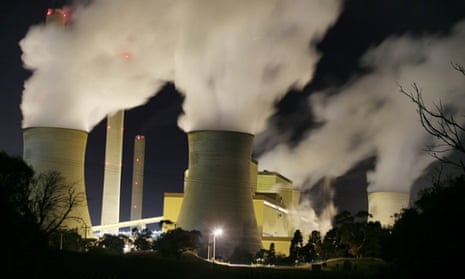One of Australia’s biggest energy companies, AGL, has pledged to shut all its coal-fired power stations by 2050.
In a surprise announcement, chief executive Andy Vesey said the company would not build, finance or acquire new conventional coal-fired power stations in Australia or extend the operating life of any of its existing stations.
By 2050 it would not have any coal-fired stations in its portfolio, Vesey said, in order to help Australia’s contribution to limiting global warming to no more than 2C in the next 35 years.
“Australia currently relies significantly on coal and gas to power its homes and industries with 88% of electricity produced from fossil fuels,” he said, releasing the company’s new greenhouse gas policy.
“To support the government’s commitment to work towards the two degree goal, companies such as AGL need to take the lead,” said Vesey.
“This will be a measured process of decarbonisation, but one which I am proud to spearhead on behalf of AGL.”
AGL’s announcement comes just months after Vesey joined from the American company AES. He replaced Michael Fraser, an enthusiastic supporter of fossil fuels who acquired coal assets such as Loy Yang power station in Victoria.
AGL also operates Liddell and Bayswater coal power stations in the Hunter Valley, NSW, and Somerton and Torrens Island in South Australia.
The dramatic policy shift would appear to put the company at odds with Tony Abbott’s vision of the industry which he says has a “bright future”.
AGL, which is Australia’s largest market-listed power company, supplies electricity to 3.8m households. Loy Yang is one of AGL’s largest brown-coal stations and produces about one-third of Victoria’s energy.
A spokeswoman for Victoria’s minister for energy and resources, Lily D’Ambrosio, welcomed the announcement.
“We believe in the science of climate change and are actively supporting the deployment of more renewable energy technology, as well as energy efficiency,” the spokeswoman said.
“We’re committed to having a rational and responsible conversation about the future of our coal resources and, importantly, what that means in terms of economic diversification in the Latrobe Valley.
The chief executive of Environment Victoria, Mark Wakeham, said the timeframe of 2050 nominated by AGL was too slow.
“It just feels a little like saying, ‘I’m going to give up smoking, but I’ll do it in a decade from now,” Wakeham said. “It’s a good intention, but the time-frames are still rather concerning showing an awareness of the problem but not the haste to address it. It is still on the distant horizon.”
AGL was just one of Australia’s producers of “dirty energy,” he said, pointing out that Victoria’s Hazelwood power station, owned by GDF Suez and supplying about 8% of the national electricity market, was one of the country’s dirtiest.
“We need to start withdrawing some of our dirtiest producers from the market like Hazelwood and we need policy solutions not only from industry but also from state and federal governments,” he said.
The Greens spokeswoman for energy and environment, Ellen Sandell, said: “Coal is on the way out. The US has shut one-fifth of its coal power stations and replaced them with clean energy, largely due to public pressure, creating four times as many jobs in the clean energy sector than shut down in dirty energy.
“I’m sceptical of AGL’s motive given they’ve been campaigning against the renewable energy target, and really this has come too late.”
Vesey said AGL would “continue to invest in low-emissions technologies to reduce the emissions intensity of Australia’s electricity supply”.
But he said the federal government must “incentivise investment in lower-emitting technology while at the same time ensuring that older, less efficient and reliable power stations are removed from Australia’s energy mix”.
Vesey said: “Decarbonisation and modernisation of Australia’s electricity system are important goals requiring effective policy.”
“It will be an ongoing, progressive process, managing the efficient operations of our assets, and the transition of our people into new generation technologies and careers,” he said.
James Grugeon, of the campaign group GetUp!, said AGL’s pledge was was a small step forward after several big steps back.
“It’s great to see AGL finally listening to the 9 out of 10 Australians who want renewable energy and making a commitment to leave dirty coal-fired power,” he said.
“It’s just a shame the company will keep pumping carbon into the atmosphere until 2050.”
AGL’s share price was largely unaffected by the announcement, falling 0.6% to $14.98 on Friday.

Comments (…)
Sign in or create your Guardian account to join the discussion